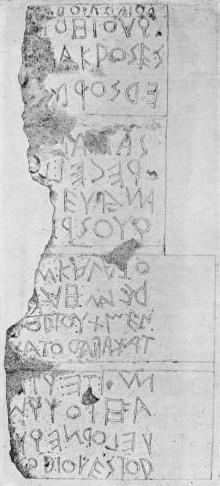boustrophedon
English

Etymology
From Lua error in Module:parameters at line 370: Parameter "sc" should be a valid script code; the value "polytonic" is not valid. See WT:LOS., from Lua error in Module:parameters at line 370: Parameter "sc" should be a valid script code; the value "polytonic" is not valid. See WT:LOS. + Lua error in Module:parameters at line 370: Parameter "sc" should be a valid script code; the value "polytonic" is not valid. See WT:LOS. + Lua error in Module:parameters at line 370: Parameter "sc" should be a valid script code; the value "polytonic" is not valid. See WT:LOS..
Pronunciation
Adverb
boustrophedon (not comparable)
- (historical, calligraphy, of writing) In a fashion such that the reading direction changes from right-to-left to left-to-right with each new line.
Adjective
boustrophedon (not comparable)
- (historical, calligraphy, of writing) Written from right-to-left and left-to-right on alternate lines.
- (figuratively) Changing direction, going back and forth.
Derived terms
Noun
boustrophedon (countable and uncountable, plural boustrophedons)
- (historical, calligraphy, of writing) Writing that is right-to-left and left-to-right on alternate lines.
- 1980, Leslie Threatte, The Grammar of Attic Inscriptions: Phonology[1], page 55:
- The number of Attic boustrophedon texts is fairly small; most of those just cited have been brought down by the experts to a date close to 550 B.C., a date to which several texts of more than one line inscribed left to right may also be assigned (cf. pp.56—57 infra), besides the four-line retrograde sep. mon. of Pediarchus cited in the previous section (cf. p.52 supra). Stone texts only really become numerous in Attica about 550, and by this time it is clear that left-to-right writing is just as common as boustrophedon, and may have been so even earlier. […] After 540 boustrophedon was certainly unusual.
- 2000, Richard Sproat, A Computational Theory of Writing Systems[2], page 61:
- (Venetic apparently had both kinds of boustrophedon, either flipping the face of the characters when switching direction or else inverting them (Lejeune, 1974, pages 180-181).)
- 2002, Elmer H. Antonsen, Runes and Germanic Linguistics[3], page 132:
- He draws a sharp distinction between true boustrophedon, which has the tops of the runes pointed in the same direction, but with a change in the direction of writing with each line, and false boustrophedon, which changes from upright to inverted runes with each line, but the lines themselves are each written in the same direction.
Derived terms
Related terms
Translations
|
German
Etymology
Borrowed from Ancient Greek βουστροφηδόν (boustrophēdón).
Pronunciation
Adjective
boustrophedon (strong nominative masculine singular boustrophedoner, not comparable)
- Alternative form of bustrophedon; boustrophedon
Declension
- English terms derived from Proto-Indo-European
- English terms derived from the Proto-Indo-European root *gʷṓws
- English 4-syllable words
- English terms with IPA pronunciation
- English terms with audio pronunciation
- English lemmas
- English adverbs
- English uncomparable adverbs
- English terms with historical senses
- en:Calligraphy
- English adjectives
- English uncomparable adjectives
- English nouns
- English uncountable nouns
- English countable nouns
- English terms with quotations
- German terms borrowed from Ancient Greek
- German terms derived from Ancient Greek
- German terms with IPA pronunciation
- German terms with audio pronunciation
- German lemmas
- German adjectives
- German uncomparable adjectives
